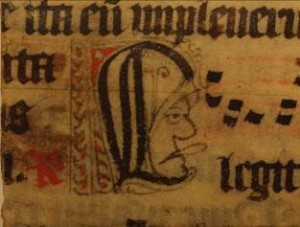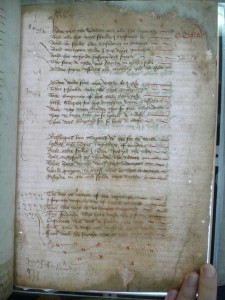The ‘Mapping Medieval Paper in England’ Project was funded by a Cambridge Humanities Research Grants Scheme 2014/15 with the aim of preparing a new dataset of Medieval Paper Manuscripts written in England between 1300 to about 1500 to consolidate the data that Dr Da Rold has collected to date.
Monthly Archives: November 2015
Conservation Report on the Pembroke Fragments
Conservation Report for Pembroke College
Manuscript fragments, stored in the University Library
A wide assortment of parchment manuscript fragments, some with illuminations, which have been used as spine linings (a few comb spine linings) or guards. Also includes a few parchment manuscript gatherings, board papers and endleaves.
The Digital Scriptorium
The Digital Scriptorium provides open digital access to over 8000 medieval and early modern manuscripts housed across over 30 academic libraries in the United States. The website provides user-friendly search tools which allow you to sift through the entire digital corpus according to geographical, historical, and thematic filters, among others. The Scriptorium allows reproduction of images and texts from the collection without prior permission for private study, teaching, and research. Using the images in published or commercial materials requires permission from the participating institution.
Digging Deeper
The Stanford online course ‘Digging Deeper’ is an excellent introduction to the more practical side of manuscript studies. The course operates as a series of videos, exercises and short tests along with links to additional, comprehensive reading material. The videos themselves are engaging and instructive, and will equip the watcher with a foundational set of terms for approaching manuscripts. Beyond this set of terms, the course has a particular focus on methods of medieval manuscript production. The course works particularly well by using these videos, which give an important opportunity to experience manuscripts in a visual way. Alongside this is the course’s focus on the digital: it never presumes that you have access to a large special collections library and is very much geared towards finding manuscripts online. It is worth noting that the course was designed to be completed as a diploma over a six week period with a forum discussion taking place after every week. However, this doesn’t detract from the central content and you can complete it at your own pace. One of the most valuable parts of the course is its introduction to palaeography and the transcription practice it allows you. In a very practical way, you are shown good transcription practice and then given the opportunity to demonstrate it online. ‘Digging Deeper’ is a very good place to start for anyone interested in pursuing manuscript studies; it should offer you a good foundation from which you might begin further enquiry.
http://online.stanford.edu/course/digging-deeper-making-manuscripts
Transcription Aids
When transcribing I found it very useful to keep a couple of transcription aids open on my web-browser. The two I found most useful are below:
The Index of Scripts on ‘Medieval Writing’
The index itself is vast to the point of daunting if you can’t already identify the script you’re working with. However, with perseverance you should be able to find a page that will help with your deciphering. The website offers a letter-by-letter index of many different scripts up to the 16th Century.
http://medievalwriting.50megs.com/writing.htm
Harvard’s ‘How to Read Medieval Handwriting’
This is a much briefer (and therefore more navigable) introduction and a good place for beginners. It explains some of the essentials of medieval handwriting and a list of common abbreviations which is particularly useful. It’s also worth scrolling to the bottom and investigating the pages on ‘Scripts’ and ‘Textual Instability’ which give engaging short introductions.
http://isites.harvard.edu/fs/docs/icb.topic453618.files/Central/editions/paleo.html#top

